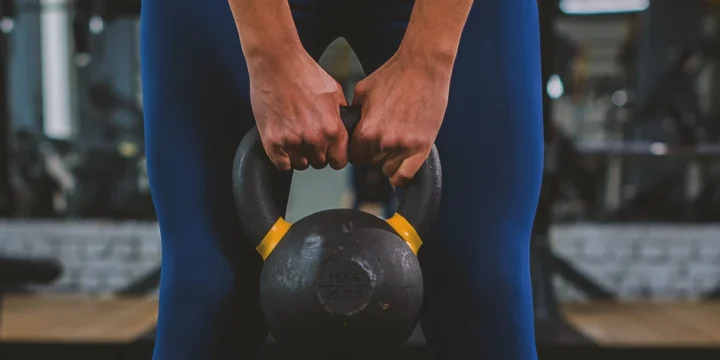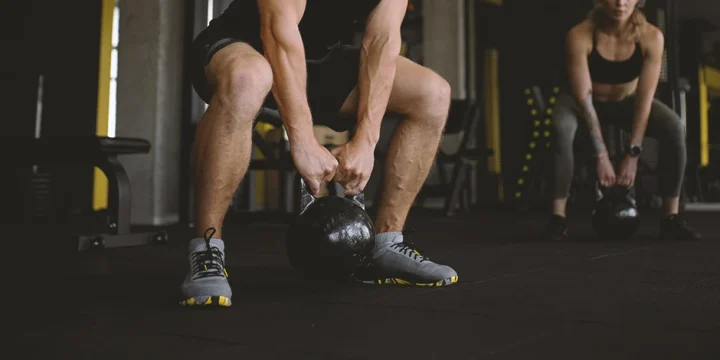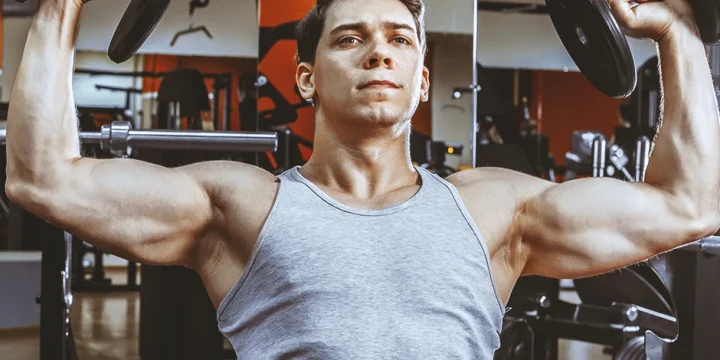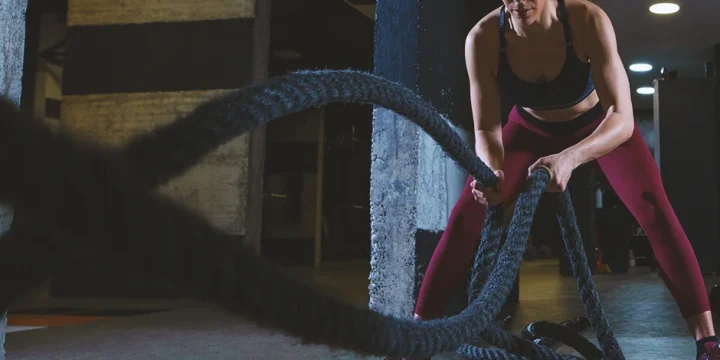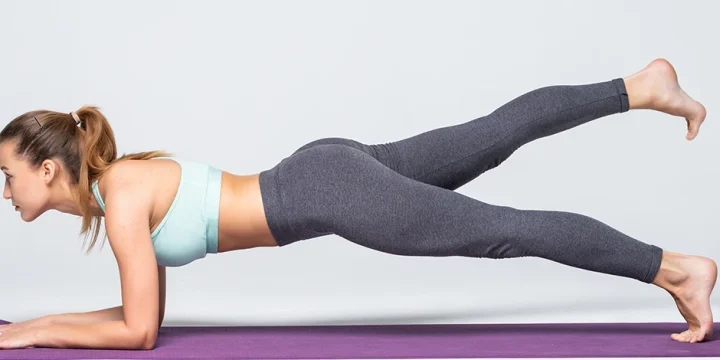With minimal equipment, lower-body HIIT exercises increase strength and burn an insane number of calories. They work the legs, glutes, quadriceps, and hamstrings while increasing heart rate.
As a certified fitness trainer, I've helped clients achieve their fitness objectives of acquiring strong lower body strength using these workouts.
In this article, I will detail my expertise on the best lower-body HIIT workout and the circuit to incorporate into your weekly regimen.
Quick Summary
- The lower body HIIT exercise includes lateral bound and squat jump, lateral lunge and burpee, curtsy lunge to reverse lunge to hop, jumping jacks, squats, high knees, fire hydrants, and flutter kicks.
- Lower body HIIT exercise is a training regimen that concentrates on intense, breathless bouts of lower body moves alternated with recovery times.
- A study from Frontiers suggested that active recovery is key for recuperating after HIIT workouts.
- The body weight high-intensity interval training (HIIT) leg workout burns a lot of calories quickly, develops and tones the glutes and leg muscles, increases stamina, and enhances athletic performance.
The Lower Body HIIT Workout

After looking at hundreds of my personalized HIIT programs and the results they've produced for my clients, here are eight effective lower-body HIIT exercises you can do in a row for an amazing cardio routine.
1. Lateral Bound and Squat Jump
How to perform lateral bound and squat jump:
- Begin standing on the left side of the mat, feet shoulder-width apart.
- Lower into an athletic posture with your knees bent and ready to go.
- Then, drive off your left leg to bound to the right laterally.
- Squat jump when you reach the right side of your mat.
- Explode off your feet to get off the ground, utilizing the strength of your legs.
- Land lightly, then repeat, bounding to the left.
2. Lateral Lunge and Burpee
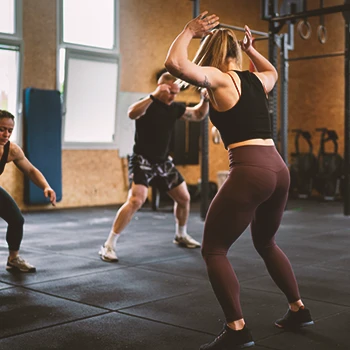
How to perform lateral lunge and burpee:
- Begin by standing with both feet hip-width apart and your knees slightly bent.
- With the right leg, step to the side, push the hips back and bend the right knee while maintaining your left foot straight.
- Consider completing a single-leg squat with the right leg while keeping your left leg straight.
- Then, drive off the right foot for action reversal, pushing back to the center.
- Perform a burpee as you reach the center by leaping your legs back into a plank position and dropping your chest to the mat.
- Push yourself upward and re-enter the pool, jumping high with your arms aloft.
- Repeat the lateral lunge on the right immediately, continuing this process for the prescribed interval.
3. Curtsy Lunge to Reverse Lunge to Hop
How to perform curtsy lunge to reverse lunge to hop:
- Stand with both feet shoulder-width apart and the hands on the hips or sides relaxed.
- Step your left leg diagonally behind and lower the right knee nearly to the floor. Your front knee ought to be bent to around 90 degrees.
- Return to the initial position by driving through your right heel.
- With your left foot, take a step back, resting on the ball of the legs while maintaining your heel off the floor.
- As you drop into a lunge, bend your knees to 90 degrees. Maintain a strong core and tucked hips (don't thrust your buttocks out).
- As you jump, push off the ball of the left foot and press your knee toward the chest.
- Return to the reverse lunge position, stepping back with your left foot.
- Repeat the process for 30 seconds on the same side, then swap sides for the last 30 seconds.
4. Jumping Jacks
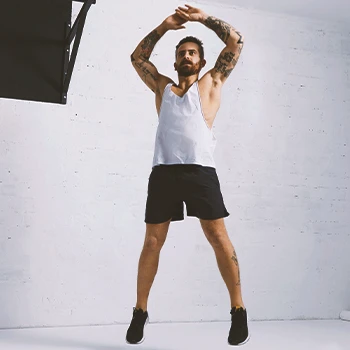
How to perform jumping jacks:
- Stand up straight, feet together, and hands by the sides.
- Jump up, and spread your legs, bringing both hands together over your head.
- Return to your starting position by jumping again.
- Repeat till the set is complete.
Related Articles:
5. Squats
How to perform bodyweight squats:
- Stand both feet slightly wider than your hip width and your toes facing front.
- Drive your hips back, bending at the ankles and knees and gently opening your knees.
- Descend down into a squat position while maintaining your toes and heels on the floor, chest up, and shoulders back.
- Strive for parallel, which means your knees are bent at a 90-degree angle.
- Return to a standing position by pressing into the heels and straightening your legs.
- Repeat for reps.
Related Article: How to Perform Squats With Resistance Bands
6. High Knees
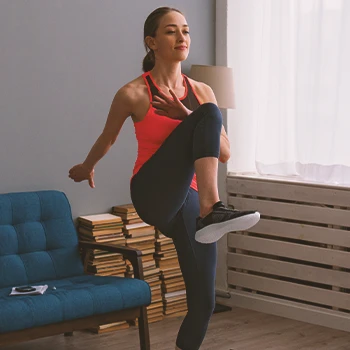
How to perform high knees:
- Place your feet roughly hip-width and stand tall.
- Maintain a high chest and tight abs as you bring your knees toward the chest one at a time.
- Swing the arms in sync with your legs, getting your hands from the hip level to chin height.
- Move as rapidly as possible for 40 seconds.
7. Fire Hydrant
- Begin on all fours, with the wrists under the shoulders, your knees under the hips, and your core engaged.
- Lift your left knee to the side, toward the roof.
- Maintain core engagement and avoid letting your body tilt to the right as you raise.
- Lower your knee to the beginning position and repeat for 30 seconds, then swap sides for another 30 seconds.
8. Flutter Kicks
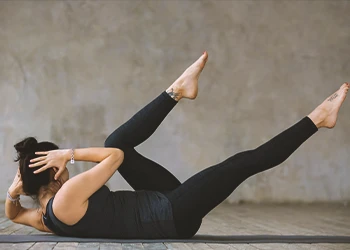
How to perform flutter kicks:
- Lie face up on the floor, arms by your sides. If your back area needs further support, place your hands behind your buttocks on both sides.
- Lift both feet approximately six inches off the ground by engaging your abs. Keep a flat lower back on the floor. If this is too difficult, raise your legs higher.
- Kick your feet for 40 seconds (as if swimming freestyle).
"This core motion is an active recovery exercise for your lower body muscles. You're able to recover your breath, but you're still exercising your core."
- Bree Branker Koegel, National Academy of Sports Medicine (NASM) Certified Trainer
The Workout Circuit

This HIIT leg workout contains 3 circuits. I highly recommend doing the circuits in the sequence provided below and strive to complete each for at least 2 sets.
The HIIT routine
Circuit 1:
- Lateral bound and squat jump
- Curtsy lunge to reverse lunge to hop
- Jumping jacks
Circuit 2:
- Lateral lunge and burpee
- High knees
- Squats
Circuit 3:
- Fire hydrant
- Flutter kicks
HIIT Workout Article:
Muscles Worked

Now that you know the greatest lower-body high-intensity interval training (HIIT) workouts, let's look at the key muscle groups these exercises focus on.
1. Quadriceps
These are the largest of your leg muscles in the front of the foot (thigh).
Related Article: The Best Quad Exercises
Quadriceps refers to four muscles, thus the prefix "quad."
This muscle group is necessary for running, walking, and kicking [1].
2. Calves
The calves may appear inconsequential, but they are essential for anybody looking to improve their running and jumping ability.
The calves also play a vital function in ankle mobility [2].
Related Article: The Best Calf Exercises
3. Hamstrings
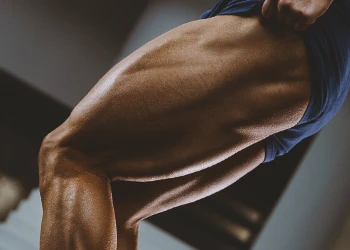
Your hamstrings are on the opposite side of the foot from your quadriceps. Your hamstrings are important in hip mobility and knee flexion [3].
The hamstrings are the major muscle stretched in the classic "squat" action.
Related Article: The Best Hamstring Exercises
4. Glutes
The gluteal muscles, often known as glutes, are a collection of three muscles that comprise the gluteal area known as the buttocks: gluteus maximus, medius, and minimus.
These muscles stabilize the pelvis and upper body, locomotion, and hip extension [4].
Related Article: The Best Glute Exercises For Mass
Maximizing Recovery After Intense Lower Body HIIT Workouts
After pushing your limits with a high-intensity lower-body workout, your muscles need the right recovery strategies to repair, rebuild, and strengthen.
Here are some effective techniques to incorporate into your post-workout routine.
1. Foam Rolling: A Key to Muscle Recovery
Foam rolling, also known as self-myofascial release, is a fantastic way to alleviate muscle tightness and improve flexibility. After a lower body HIIT session, focus on rolling out your quadriceps, hamstrings, calves, and glutes. This not only helps in reducing muscle soreness but also increases blood flow, enhancing the recovery process. Spend about 5-10 minutes gently rolling over each muscle group, paying extra attention to any particularly sore spots.
2. Contrast Water Therapy: The Hot and Cold of Recovery
Contrast water therapy, alternating between hot and cold showers, can be remarkably beneficial after a strenuous workout. Start with three minutes of warm water, followed by one minute of cold water. Repeat this cycle 3–4 times. This method helps reduce muscle soreness and inflammation by alternating vasodilation and vasoconstriction, promoting blood flow and aiding in the removal of lactic acid from the muscles.
3. Active Recovery: Keep Moving to Improve
A study from Frontiers suggested that active recovery is key for recuperating after HIIT workouts [5].
On your rest days, consider engaging in active recovery.
Activities like walking, light cycling, or a gentle yoga session can significantly aid your recovery. Active recovery helps maintain blood flow to the muscles, reducing stiffness and promoting nutrient and oxygen delivery to the muscles for repair.
4. Nutrition and Hydration: Fueling the Recovery Process
Post-workout nutrition is crucial. Focus on consuming a balanced meal with a good mix of protein and carbohydrates within 45 minutes of your workout. Protein aids in muscle repair, while carbohydrates replenish your energy stores. Don't forget to hydrate as well. Replacing lost fluids is essential for optimal recovery and performance.
5. Quality Sleep: The Unsung Hero of Recovery
Never underestimate the power of a good night’s sleep. Quality sleep is when the magic of muscle repair and growth happens. Aim for 7–9 hours of uninterrupted sleep to allow your body to undergo its natural recovery processes.
FAQs
What Are the Benefits of Lower Body HIIT Workouts?
The benefits of lower-body HIIT workouts include getting the heart rate up quickly and strengthening the quadriceps, glutes, hip adductors, and hamstrings.
What Do 20 Minutes of HIIT Do?
Twenty minutes of HIIT will get you burning some serious calories. While this amount can vary based on your weight and the HIIT you undertake, you should anticipate burning between 150 and 400 calories.
What Are the 3 Stages of a HIIT Workout?
The three stages of HIIT workout are warm-up, exercise, and cool-down.
Supplementing Your Lower Body HIIT Workout
You should perform this explosive lower body HIIT workout circuit two to three times weekly.
They are great for elevating your heart rate, strengthening your lower body, and burning more calories for weight loss.
Incorporate these lower body workouts with the top-rated post-workout supplements into your strength training routine for maximum benefits.
After putting the supplements into our routine test, they proved effective by increasing our endurance and energy and boosting our recovery for our next workout session.
References:
- https://www.ncbi.nlm.nih.gov/books/NBK513334/
- https://www.ncbi.nlm.nih.gov/books/NBK459362/
- https://www.ncbi.nlm.nih.gov/books/NBK546688/
- www.researchgate.net/publication/26338168
- https://www.frontiersin.org/journals/physiology/articles/10.3389/fphys.2018.00415/full
About The Author
You May Also Like

